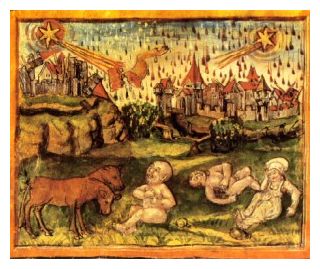I was not surprised to see the paper below this week in Science. I have read all of Mike Baillie's books, as well as Catastrophe by David Keys, leaving me feeling as though I had actually lived through the 6th Century.
The inescapable conclusion of the popular books and the hard science is that something quite horrid happened during this period. Dr. Baillie, one the world's most experienced and published dendrochronologists, has maintained for over a decade that the sum of all the evidence; tree rings, ice chemistry and (heretically) written accounts from the time, suggest that it was a horror from above - not below - that led to the worldwide decline of trees, global cultural upheavals, and human health reversals such as the Justinian Plague.
As might be expected, other scientists disagreed with Baillie's conclusion and instead finger an unidentified equatorial volcano for the misery of the era. Chief among these critics is Keith Briffa of "Climategate" fame.
Over the next week or two, the Tusk plans to dig more deeply in the drift of evidence for the ~536 event and it's cause. I hope to bring attention to what I believe is another attempt to brush away the reasoned conclusion of a respected mainstream scientist - Mike Balllie - by a group of thinkers consumed by an agenda that discourages free inquiry or alternative explanations.
The dispute can be characterized as the two typical camps of thought in our discussion:
- Those who believe the earth climate during human history is a closed system without the influence of space debris; and,
- Others like Baillie and many Tusk readers who believe that space borne material has from time-to-time intersected the earth during recorded human history and changed the course of civilizations by inducing rapid climate change and its consequences.
The paper referenced above, and published in Science can be viewed here.




One really has to contort one's brain to come up with any other conclusion than what Baillie is presenting based on reams of evidence.